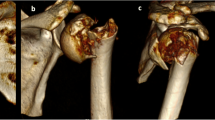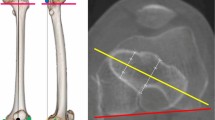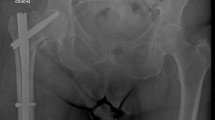Abstract
Introduction
Nailing of the proximal humerus is an established method for the treatment of proximal humerus fractures. Choice of the correct length for potentially four proximal locking screws is essential for postoperative outcome. Due to positioning of the patient, intraoperative determination of the correct length of the anteroposterior (AP) screw with the x-ray beam is particularly challenging even for experienced surgeons. We hypothesized that there would be a correlation between the projected lengths of the different proximal locking screws and therefore the length of the AP-screw could be determined based on the three lateromedial (LM) screws.
Materials and methods
In this retrospective study (level of evidence: III) CT-scans of shoulders of 289 patients were 3D reconstructed with the program Horos. Using the manufacturer Stryker's instructions, the four proximal locking screws of the T2 Humeral Nail system were reproduced in the 3D reconstructed shoulders. The length of the AP-screw was correlated with the lengths of the LM-screws by Linear Regression and Multiple Linear Regression.
Results
The results of this study showed that the lengths of proximal locking screws in proximal humeral nailing correlated significantly with each other. Based on the given data, a formula could be established to calculate the length of the AP-screw based on the lengths of the LM-screws with a probability of 76.5%.
Conclusions
This study was able to show that the length of the AP-screw could be determined from the intraoperatively measured lengths of the LM-screws. As our findings base on measurements performed in CT scans, clinical studies are needed to support our data.





Similar content being viewed by others
Data availability
The data that support the findings of this study are not openly available due to reasons of sensitivity and are available from the corresponding author upon reasonable request. Data are located in controlled access data storage at University Medical Center of Cologne.
References
Calvo E, Morcillo D, Foruria AM, Redondo-Santamaría E, Osorio-Picorne F, Caeiro JR (2011) Nondisplaced proximal humeral fractures: High incidence among outpatient-treated osteoporotic fractures and severe impact on upper extremity function and patient subjective health perception. J Shoulder Elbow Surg. 20(5). https://doi.org/10.1016/j.jse.2010.09.008.
Palvanen M, Kannus P, Niemi S, Parkkari J (2006) Update in the epidemiology of proximal humeral fractures. In: Clinical Orthopaedics and Related Research. DOI: https://doi.org/10.1097/01.blo.0000194672.79634.78.
Tsuda T (2017) Epidemiology of fragility fractures and fall prevention in the elderly: A systematic review of the literature. Current Orthopaedic Practice. 28(6). https://doi.org/10.1097/BCO.0000000000000563.
Court-Brown CM, Caesar B (2006) Epidemiology of adult fractures: a review. Injury. 37(8). https://doi.org/10.1016/j.injury.2006.04.130.
Lübbeke A, Stern R, Grab B, Herrmann F, Michel JP, Hoffmeyer P (2005) Upper extremity fractures in the elderly: consequences on utilization of rehabilitation care. Aging Clin Exp Res 17(4). DOI: https://doi.org/10.1007/BF03324610.
Soliman OA, Koptan WMT (2013) Four-part fracture dislocations of the proximal humerus in young adults: Results of fixation. Injury. 44(4). https://doi.org/10.1016/j.injury.2012.09.005.
Nho SJ, Brophy RH, Barker JU, Cornell CN, MacGillivray JD (2007) Management of proximal humeral fractures based on current literature. Journal of Bone and Joint Surgery. 89(suppl_3). https://doi.org/10.2106/jbjs.g.00648.
Goldman RT, Koval KJ, Cuomo F, Gallagher MA, Zuckerman JD (1995) Functional outcome after humeral head replacement for acute three- and four-part proximal humeral fractures. J Shoulder Elbow Surg 4(2). https://doi.org/10.1016/S1058-2746(05)80059-X.
de la Hoz J, Hernández Cortés P, Tercedeor Sánchez J (2001) Surgical treatment of three-part proximal humeral fractures. Acta Orthopaedica Belgica. 67(3).
Hashmi FR, Mayr E. A new nail with a locking blade for complex proximal humeral fractures. Euro J Orthopaedic Surg Traumatol. 2016;26(8). https://doi.org/10.1007/s00590-016-1817-4.
Shi X, Liu H, Xing R, Mei W, Zhang L, Ding L, Huang Z, Wang P (2019) Effect of intramedullary nail and locking plate in the treatment of proximal humerus fracture: An update systematic review and meta-analysis. J Orthopaedic Surg Res 14(1). https://doi.org/10.1186/s13018-019-1345-0.
Dilisio MF, Nowinski RJ, Hatzidakis AM, Fehringer E v (2016) Intramedullary nailing of the proximal humerus: Evolution, technique, and results. J Shoulder Elbow Surg. 25(5). https://doi.org/10.1016/j.jse.2015.11.016.
Lopiz Y, Garcia-Coiradas J, Garcia-Fernandez C, Marco F (2014) Proximal humerus nailing: a randomized clinical trial between curvilinear and straight nails. J Shoulder Elbow Surg 23(3). https://doi.org/10.1016/j.jse.2013.08.023.
Nijs S, Sermon A, Broos P (2008) Intramedullary fixation of proximal humerus fractures: do locking bolts endanger the axillary nerve or the ascending branch of the anterior circumflex artery? A cadaveric study. Patient Saf Surg 2(1). https://doi.org/10.1186/1754-9493-2-33.
Baumgaertner MR, Solberg BD (1997) Awareness of tip-apex distance reduces failure of fixation of trochanteric fractures of the hip. J Bone Joint Surg Ser B 79(6). https://doi.org/10.1302/0301-620X.79B6.7949.
Abdulkareem I (2012) A review of tip apex distance in dynamic hip screw fixation of osteoporotic hip fractures. Nigerian Med J 53(4). https://doi.org/10.4103/0300-1652.107550.
Baumgaertner MR, Curtin SL, Lindskog DM, Keggi JM (1995) The value of the tip-apex distance in predicting failure of fixation of peritrochanteric fractures of the hip. J Bone Joint Surg Ser A 77(7). https://doi.org/10.2106/00004623-199507000-00012.
Saul D, Himmelmann T, Dresing K (2017) Humeral tip-apex-distance as a prognostic marker for proximal humeral fractures in 203 Patients. Open Orthopaedics J 11(1). https://doi.org/10.2174/1874325001711010297.
Barth J, Garret J, Boutsiadis A, Sautier E, Geais L, Bothorel H, Godenèche A (2018) Is global humeral head offset related to intramedullary canal width? A computer tomography morphometric study. J Exp Orthopaedics 5(1). https://doi.org/10.1186/s40634-018-0148-2.
Hayes AF, Krippendorff K (2007) Answering the call for a standard reliability measure for coding data. Commun Methods Measures 1(1). https://doi.org/10.1080/19312450709336664.
Sproul RC, Iyengar JJ, Devcic Z, Feeley BT (2011) A systematic review of locking plate fixation of proximal humerus fractures. Injury. 42(4) https://doi.org/10.1016/j.injury.2010.11.058.
Krappinger D, Bizzotto N, Riedmann S, Kammerlander C, Hengg C, Kralinger FS (2011) Predicting failure after surgical fixation of proximal humerus fractures. Injury. 42(11). https://doi.org/10.1016/j.injury.2011.01.017.
Wu JW, Shen HL, Liu LM, Gao ZH (2016) Analysis of early failure of the PHILOS in proximal humerus fractures. Beijing da xue xue bao Yi xue ban = Journal of Peking University Health sciences. 48(4).
Jung SW, Shim SB, Kim HM, Lee JH, Lim HS (2015) Factors that influence reduction loss in proximal humerus fracture surgery. J Orthopaedic Trauma. 29(6). https://doi.org/10.1097/BOT.0000000000000252.
Cohen J (1988) Statistical power analysis for the behavioural sciences. Hillside. NJ: Lawrence Earlbaum Associates.
Krippendorff K (2010) Content Analysis: An Introduction to Its Methodology (2nd ed.). Organizational Research Methods. 13(2).
Acknowledgements
We thank Julia Halbach (University of Cologne), Eva Hubrich (University of Cologne) and Marc Decker (University of Cologne) for their measurements and contribution to this publication.
Funding
This research did not receive any specific grant from funding agencies in the public, commercial, or not-for-profit sectors.
Author information
Authors and Affiliations
Contributions
Conceptualization: MS, TCK, KW; methodology: MS, MH, KW; formal analysis and investigation: MS; writing—original draft preparation: MS; writing—review and editing: MS, TCK, PF, GB, AH, MH, LPM, KW; resources: PF, GB, LPM; ethics application: AH; supervision: KW.
Corresponding author
Ethics declarations
Conflict of interest
Lars P. Müller and Kilian Wegmann receive research support and payment as a consultant by Stryker / Tornier Company. Michael Hackl receives research support by Stryker / Tornier Company. For the remaining authors none were declared.
Ethical approval
This study was approved by Ethikkommission Universität zu Köln.
Informed consent
We the authors hereby confirm, that that our work is not under consideration for publication elsewhere, that its publication is approved by all authors and tacitly or explicitly by the responsible authorities where the work was carried out, and that, if accepted, it will not be published elsewhere in the same form, in English or in any other language, including electronically without the written consent of the copyright-holder.
Additional information
Publisher's Note
Springer Nature remains neutral with regard to jurisdictional claims in published maps and institutional affiliations.
Rights and permissions
Springer Nature or its licensor (e.g. a society or other partner) holds exclusive rights to this article under a publishing agreement with the author(s) or other rightsholder(s); author self-archiving of the accepted manuscript version of this article is solely governed by the terms of such publishing agreement and applicable law.
About this article
Cite this article
Sarter, M., Koslowsky, T.C., Fervers, P. et al. Correlation of head screw lengths in proximal humerus nailing: a CT-based study on 289 cases. Arch Orthop Trauma Surg 143, 5027–5034 (2023). https://doi.org/10.1007/s00402-023-04875-1
Received:
Accepted:
Published:
Issue Date:
DOI: https://doi.org/10.1007/s00402-023-04875-1




